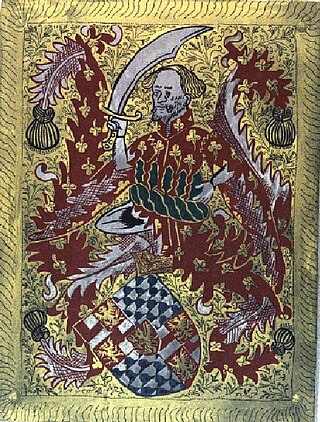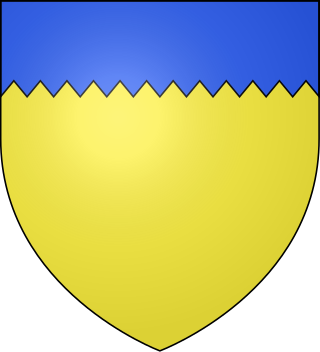Earl is a rank of the nobility in the United Kingdom. In modern Britain, an earl is a member of the peerage, ranking below a marquess and above a viscount. A feminine form of earl never developed; instead, countess is used.

Richard Woodville, 1st Earl Rivers, also Wydeville, was the father of Elizabeth Woodville and father-in-law of Edward IV.

Duke of Kent is a title that has been created several times in the peerages of Great Britain and the United Kingdom, most recently as a royal dukedom for the fourth son of King George V. Since 1942, the title has been held by Prince Edward, a first cousin of Queen Elizabeth II.

Duke of Somerset, from the county of Somerset, is a title that has been created five times in the peerage of England. It is particularly associated with two families: the Beauforts, who held the title from the creation of 1448, and the Seymours, from the creation of 1547, in whose name the title is still held. The present dukedom is unique, in that the first holder of the title created it for himself in his capacity of Lord Protector of the Kingdom of England, using a power granted in the will of his nephew King Edward VI.

Earl of Leicester is a title that has been created seven times. The first title was granted during the 12th century in the Peerage of England. The current title is in the Peerage of the United Kingdom and was created in 1837.

Earl of Devon is a title that has been created several times in the Peerage of England. It was possessed first by the Redvers family, and later by the Courtenay family. It is not to be confused with the title of Earl of Devonshire, which is held by the Duke of Devonshire, although the letters patent for the creation of the latter peerages used the same Latin words, Comes Devon(iae). It was a re-invention, if not an actual continuation, of the pre-Conquest office of Ealdorman of Devon.

Duke of Suffolk was a title that has been created three times in the peerage of England.
Earl of March is a title that has been created several times, respectively, in the Peerage of Scotland and the Peerage of England. The title derives from the "marches" or borderlands between England and either Wales or Scotland, and it was held by several great feudal families which owned lands in those districts. Later, however, the title came to be granted as an honorary dignity, and ceased to carry any associated power in the marches.

Baron Stafford, referring to the town of Stafford, is a title that has been created several times in the Peerage of England. In the 14th century, the barons of the first creation were made earls. Those of the fifth creation, in the 17th century, became first viscounts and then earls. Since 1913, the title has been held by the Fitzherbert family.

Earl of Strafford is a title that has been created three times in English and British history.
The County of Aumale, later elevated to a duchy, was a medieval fief in Normandy, disputed between France and England during parts of the Hundred Years' War.

Earl of Surrey is a title in the Peerage of England that has been created five times. It was first created for William de Warenne, a close companion of William the Conqueror. It is currently held as a subsidiary title by the Dukes of Norfolk.

Edmund Grey, 1st Earl of Kent, KB, English administrator, nobleman and magnate, was the son of Sir John Grey, KG and Constance Holland. His main residence was at Wrest near Silsoe, Bedfordshire.

Reynold Grey, 3rd Baron Grey of Ruthyn, a powerful Welsh marcher lord, succeeded to the title on his father's death in July 1388.

Richard Grey, 3rd Earl of KentKG was an English peer.
Henry Grey, 10th Earl of Kent, known as Lord Ruthin from 1639 to 1643, was an English politician who sat in the House of Commons in 1640 and succeeded to the title Earl of Kent in 1643.
Anne Woodville, Viscountess Bourchier was an English noblewoman. She was a younger sister of Queen Consort Elizabeth Woodville to whom she served as a lady-in-waiting. Anne was married twice; first to William Bourchier, Viscount Bourchier, and secondly to George Grey, 2nd Earl of Kent. Anne was the grandmother of the disinherited adulteress Anne Bourchier, 7th Baroness Bourchier, and an ancestress of Robert Devereux, 2nd Earl of Essex.
Richard Grey, 3rd Earl of Tankerville, 8th Lord of Powys fought on the side of the House of York in the War of the Roses.

Butler is the name of a noble family whose members were, for several centuries, prominent in the administration of the Lordship of Ireland and the Kingdom of Ireland. They rose to their highest prominence as Dukes of Ormonde. The family has produced multiple titles such as Baron Cahir, Baron Dunboyne, Viscount Ikerrin, Viscount Galmoye, Viscount Mountgarret, Viscount Thurles, Earl of Carrick, Earl of Kilkenny, Earl of Ormond, Earl of Ossory, Marquess of Ormonde and Duke of Ormonde. Variant spellings of the name include le Boteler and le Botiller. The Butlers were descendants of Anglo-Norman lords who participated in the Norman invasion of Ireland in the 12th century. The surname has its origins in the hereditary office of "Butler (cup-bearer) of Ireland", originating with Theobald Walter, 1st Chief Butler of Ireland. The arms of later family members depicted three cups in recognition of their original office.

The Holland family was a medieval-era English noble family. Many Hollands were Dukes, Earls, Knights and Barons in medieval England, and they played significant roles in the struggles for the crown in the fourteenth and fifteenth century.












